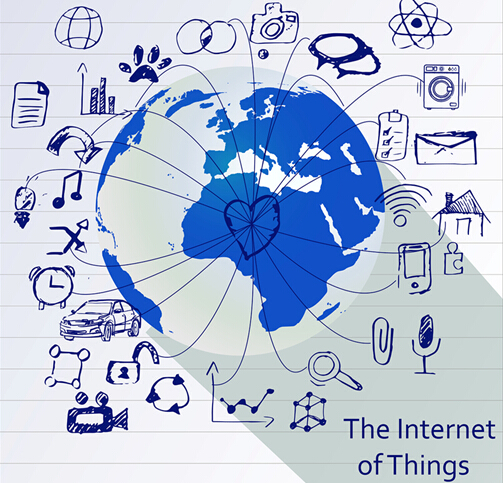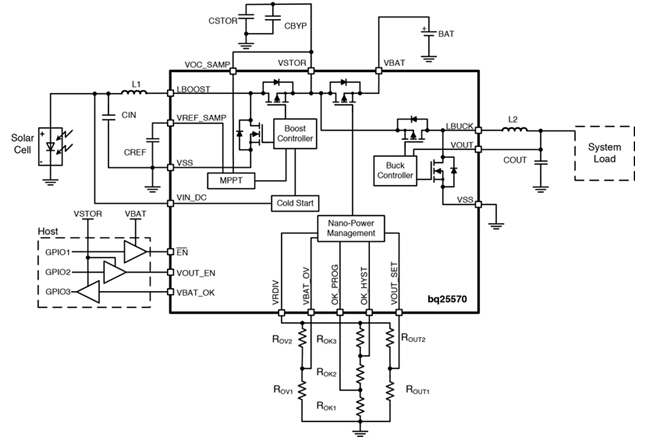The Internet of Things is one of the hot topics of the moment. But most focus on communication standards and the security of information and devices. Equally important, what is overlooked is how to properly power a large number of devices that make up the Internet of Things. What constitutes the Internet of Things? The idea behind the Internet of Things is to connect everything that is worth discussing or listening for communication.
In many cases, the Internet of Things connected projects can be existing devices that have recently gained communication capabilities, or new products created to enrich the information environment. Usually these devices are connected wirelessly. Wireless connectivity places new demands on power developers. Wireless connectivity is popular for its high degree of flexibility, and this flexibility should not be limited by any need for any particular power connection.
Figure 1 shows a view of the Internet of Things. As the picture shows, everything can be connected. We also see that a subset of this concept is the wireless cloud. Wireless clouds provide connectivity for users and their devices. The white paper published by the Energy Efficiency Telecommunications Center (CEET) in April 2013 predicts that the wireless cloud will consume 43 terawatt hours (TWh) this year (1) [1]. The power consumption of the wireless network will account for 90% of the above power consumption. Compared with the wireless cloud in 2012, it only consumes 9.2 TWh, and the energy consumption increases greatly.

Figure 1. View of the Internet of Things
As more equipment and traffic become part of the IoT infrastructure, power consumption is expected to climb. This has become a serious challenge for power supply designers. At some point in the future, the expansion of IoT will be limited by the amount of energy it consumes. So let's start thinking about some of the tasks that power supply designers have to deal with.
We will start with wireless sensors. As shown in Figure 1, the devices and related infrastructure integrated to form an IoT include small devices or wireless sensors that can monitor the environment, appliances that need to communicate their status, wearable electronics, security systems, automotive, and industrial Devices, as well as the aforementioned wireless networking devices. Many people think that IoT is mainly composed of wireless sensors that can transmit important information. .
Wireless sensor
Wireless sensors are often placed in environments where access is cumbersome or expensive to access. This requires that its energy supply lasts for a long time, typically over 10 years, or wireless sensors can extract energy from their environment in a reliable manner. Therefore, this requires a power management solution that must achieve the goal of saving energy during energy management operations. Wireless sensors also have very high peak-to-average power ratios, which in some cases are greater than 100.
Figure 2 shows an example of various power modes for wireless sensors. In this example, the sensor is in sleep mode most of the time, but may wake up into communication mode for measurement - which also allows the system to recognize that the sensor is available. And during longer intervals, the sensor can provide more information to the system. This transmission may require more energy and therefore depends on the available energy stored. Power management solutions need to deliver the peak power required while consuming very little average energy. If the environmental energy of such systems is low, the power management solution must be able to harvest energy until there is enough energy for the required facilities.

Figure 2. Wireless sensor power distribution
Figure 3 shows an example of the implementation of such a system [2]. In this example, Maximum Power Point Tracking (MPPT) is based on the ratio of the MPPT voltage to the open source voltage of the photovoltaic source. This MPPT implementation minimizes energy consumption while performing MPPT functions. This example also integrates energy storage. Since the service life of the energy storage component is very important, care must be taken not to overcharge and discharge the component. In this example, the levels are set for the minimum and maximum storage voltages.

Figure 3. Energy management for wireless sensors
In order to inform the system of the stored energy level, the designer can configure the voltage level from the outside, mainly in the place where the notification, VBAT_OK can be given. The buck regulator is also integrated into the solution to power the system load. This complete system has a typical quiescent current of 500nA, enabling high efficiency even at low currents. For example, when the input current is 500 mV and the charging current is 100 uA, the efficiency of the boost converter can be greater than 70%.
Smart Appliances
Another type of thing that makes up IoT is home appliances. Many times, we have never thought of how such Hebei will become part of IoT, but it is through IoT that we can intelligently control our washing machines, refrigerators, etc. Traditionally, we thought that by simply connecting them to the grid and setting up some information, they can start working. In the example of a washing machine, it may sound a beep when the cycle is completed, but that's it. However, today's networked appliances can provide information by refilling the tone. What impact will this have on power supply designers?
These appliances were originally turned on only when there was a task to execute, and now need to remain open at all times, or at least some of the features must remain open at all times. In order to effectively power these functions that are always on. This new requirement adds to the task of the power supply designer. Since these devices require a large amount of power to perform their tasks, in most cases they are connected to the grid, thus eliminating the need for energy harvesting. However, because they are always on, static power and efficiency are critical to the new connectivity. Many times, these connectivity functions are performed wirelessly and communicate with the local network. This sets the power level requirement below 10W. This low power level is typically achieved with an AC/DC flyback solution. There are many integrated flyback solutions to choose from, but this particular application has its own requirements. Figure 4 shows an example of such a power solution to meet the needs of connecting to the IoT.

Figure 4. Low-power AC/DC solution for appliance connections
The flyback example of Figure 4 has several main features. The first is that it has very low standby power consumption, less than 30mW. Since the connection must always be in a ready state, even if the appliance is idle. Therefore, low power consumption is especially important. Another aspect is low electromagnetic interference (EMI) because the device will often power wireless communication circuits. In this example, the controller uses valley switches and frequency jitter to help reduce EMI.
Another aspect is the size of the power solution. The size itself is usually not a problem, and it is critical to see how the size affects the final cost. IoT is an exciting technology that allows the washing machine to tell you that the clothes have been washed and dried, or that the refrigerator tells you that the door is not closed by the information sent to your phone, but the consumer does not want to spend unnecessary money. . So the solution needs to minimize the cost of the power solution. One way to achieve this is to reduce the size. By operating at a higher frequency, in this case the frequency is 115 kHz, size reduction can be achieved.
wireless network
Wireless networks are called energy “greats†and are one of IoT's most interesting challenges. There are many ongoing power supply design developments that can help solve this problem. From envelope tracking power amplifiers to digital radio frequency (RF) power amplifiers, everything is research and development at base stations. There are countless examples of this. Given that many base stations are powered by the grid, there is an opportunity to make that front-end power factor control (PFC) power supplies more efficient. Figure 5 illustrates one such method. This is the power level of the bridgeless PFC. This system can be made more efficient by removing the diode bridge. There are many different bridgeless PFC topologies, but we will focus on the version of the continuous conduction mode (CCM) push-pull output circuit.

Figure 5. Push-pull output circuit bridgeless PFC
The benefits of this topology are reduced component count and elimination of bridge loss. By using gallium nitride (GaN) switching devices, we can further increase efficiency. These devices (Q3 and Q4) provide lower gate losses, allowing for higher frequency operation. Other parasitic losses (such as Coss) are also lower. In addition, there is no intrinsic body diode, so the reverse recovery loss is minimal. Q1 and Q2 are switched at line frequency, and they can be silicon metal-oxide-semiconductor field-effect transistors (MOSFETs), which can reduce losses more than diodes alone.
Looking to the future
IoT brings many new challenges to power supply designers, only a few are mentioned here. The adoption and coverage of IoT depends to a large extent on the reduction in energy demand, which can be achieved by collecting environmental energy to minimize household energy requirements and reduce total network energy demand. As we develop new technologies for energy harvesting, we must keep in mind that reducing energy requirements remains critical to promoting development. The lower the demand for energy, the more likely it is to get energy from the environment.
It is also important to reduce the energy requirements of the grid. Think about the impact of each individual grid-powered application that can mask the efficiency of a few percent. Only the impact of overall efficiency can attract the attention of the government. It is not a washing machine or a base station that can do this, but millions of applications that make up the energy demand. Fortunately, power supply designers have new technologies that can meet these challenges. In some cases, processing techniques enable high voltage components to integrate low voltage control functions. In other cases, WBG devices can improve high voltage switching conditions by allowing low losses when switching speeds are higher. For power supply designers, our era will definitely be more and more exciting.
Texas Instruments (TI)
references
1. "Power consumption of wireless clouds", Energy Efficient Telecommunications Center (CEET) published in April 2013
2. "bq25570 Product Specification", Texas Instruments (TI)
Solar Battery Pack,Dewalt 14.4 V Battery,External Battery Pack,Mophie Battery Pack
Zhejiang Xinghai Energy Technology Co.,Ltd , https://www.headwayli-battery.com